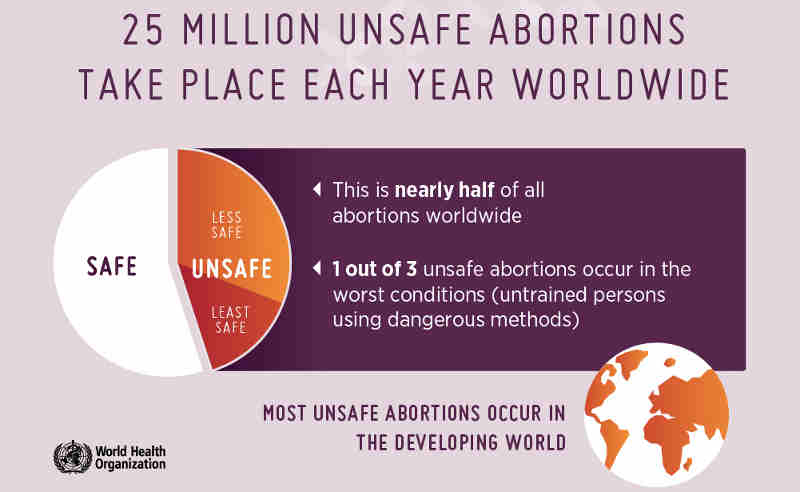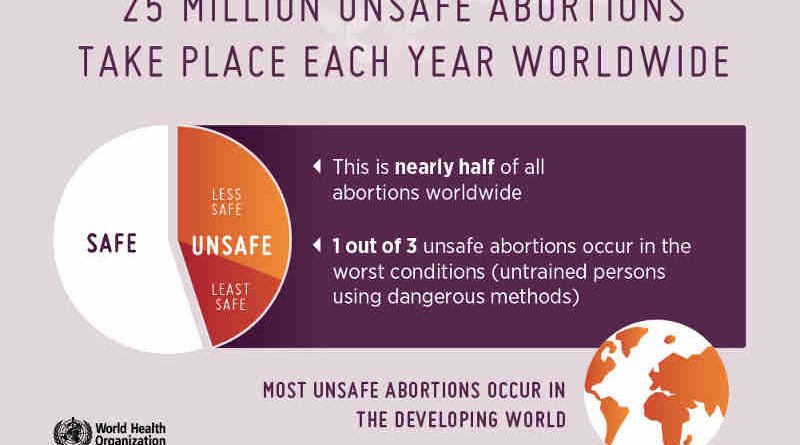25 Million Unsafe Abortions Occur Each Year: WHO

Worldwide, 25 million unsafe abortions (45% of all abortions) occurred every year between 2010 and 2014, according to a new study by WHO and the Guttmacher Institute published Thursday in The Lancet. The majority of unsafe abortions, or 97%, occurred in developing countries in Africa, Asia and Latin America.
“Increased efforts are needed, especially in developing regions, to ensure access to contraception and safe abortion,” says Dr Bela Ganatra, lead author of the study and a scientist in the WHO Department of Reproductive Health and Research.
The new Lancet study provides estimates on safe and unsafe abortions globally. For the first time, it includes sub-classifications within the unsafe abortion category as less safe or least safe.
[ Poisonous Particles + Noise Nuisance = Death for Delhi ] – Research Report
The distinction allows for a more nuanced understanding of the different circumstances of abortions among women who are unable to access safe abortions from a trained provider.
When abortions are performed in accordance with WHO guidelines and standards, the risk of severe complications or death is negligible, WHO suggests.
Approximately 55% of all abortions from 2010 to 2014 were conducted safely, which means they were performed by a trained health worker using a WHO-recommended method appropriate to the pregnancy duration.
Almost one-third (31%) of abortions were “less safe,” meaning they were either performed by a trained provider using an unsafe or outdated method such as “sharp curettage”, or by an untrained person albeit using a safe method like misoprostol, a drug that can be used for many medical purposes, including to induce an abortion.
[ Tobacco Use Kills Over 7 Million People Each Year: WHO Report ]
About 14% were “least safe” abortions provided by untrained persons using dangerous methods, such as introduction of foreign objects and use of herbal concoctions.
Deaths from complications of unsafe abortion were high in regions where most abortions happened in the least safe circumstances. Complications from “least-safe” abortions can include incomplete abortion (failure to remove all of the pregnancy tissue from the uterus), haemorrhage, vaginal, cervical and uterine injury, and infections.
The study also looks at the contexts that commonly result in women seeking unsafe abortions, including countries’ laws and policies on abortion, the financial cost of accessing safe abortion services, the availability of safe abortion services and trained health providers, and societal attitudes toward abortion and gender equality.
Earlier this year, WHO and the Population Division of the United Nations Department of Economic and Social Affairs launched a new, open-access database of laws, policies and health standards on abortion in countries worldwide.
The database aims to promote greater transparency of abortion laws and policies, as well as to improve countries’ accountability for the protection of women and girls’ health and human rights.




![Children demonstrating in the streets of New Delhi so that the Indian government should protect them from dust pollution, noise pollution, and air pollution of extended FAR construction activity in occupied housing societies. Photo and Campaign by Rakesh Raman [ Click the photo to know the details. ]](https://www.ramanmedianetwork.com/wp-content/uploads/2017/04/dwkpol1-390x205.jpg)